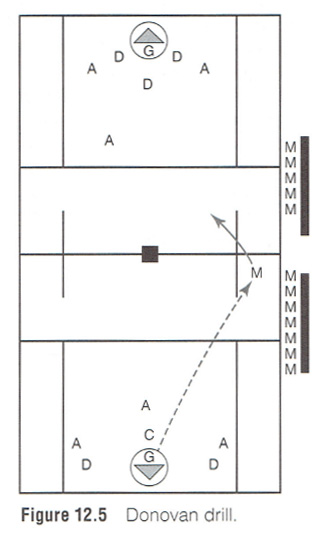|
By: Jack Kaley and Rich Donovan Originally Published in: Lacrosse Essentials Provided by: Human Kinetics While attending the National Lacrosse Coaches Convention in 1984, I noted the large number of clinicians who presented on the topic of transition offense. I had lengthy conversations with two defensive coaches I have always relied on through the many years for their insights and expertise. Bob Shillinglaw (University of Delaware) and Dave Slafkosky (United States Military Academy and University of Maryland) agreed that a presentation on transition defense was long overdue. I presented a transition drill at the following year's convention in Philadelphia. While coaching at the C.W. Post campus of Long Island University, we called the drill full field transition. Jack Kaley introduced it as the Donovan drill in his practices that spring. Purpose This drill teaches and highlights all settled and unsettled situations that can occur during a lacrosse game. It also is a disguised conditioning drill because of the number of times the ball goes up and down the field. The coach introduces each progression as play develops in sequence. Players learn to identify whether the numbers are even, they have an offensive advantage, or they are playing at a defensive disadvantage. Setup Divide the team into two equal groups. The teams each have three attack players, three defensemen, and a goalie on its end of the field within the box area. Player positions are the same as before the face-off in a game. All midfielders report to the substitution box on their defensive half of the field. The coach is at the face-off X with at least a dozen balls. Each goal should also contain a dozen balls. Execution The coach rolls the ball out to a midfielder entering the field of play from the box area to begin the drill with a traditional 4v3 fast break. The opposing midfielder remains on his side of the box area ready to enter the field of play in his defensive half by moving toward the ball after a save, turnover, ball out-of-bounds, or goal. Any defensive teammate can pass the ball to the player at the box area. This creates a 4v4 opportunity going in the opposite direction. The sequence of play continues with the progression of 5v4, 5v5, 6v5, and a concluding 6v6 (see figure 12.5). Coaching Points
Once the drill is completed, the advantage rotates in the next cycle. This provides the opportunity for all players to play with and without the numbers advantage. Emphasize conditioning and playing at full speed. Role reversal is strongly suggested and can be accomplished by rotating all positions (attack, midfield, defense) in the substitution-box area and on the field of play. This also creates a high level of energy. |







